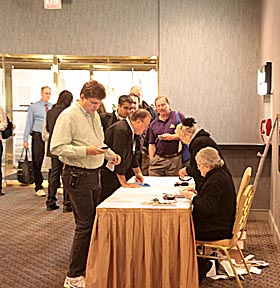
The line at the typical hotel check-in is much shorter than at the convention center.

2010 Consumers Electronics Show: A first-timers experiences.
The first week in January has Las Vegas hosting the world's largest electronics show, the CES. 2010 was no exception and over four days 120,00 people jammed together to view the newest gadgets to be released by both established big-name manufacturers like Sony and tiny, entrepreneur companies hoping to strike it big. To anyone interested in electronics of any kind, the CES is the Mecca that pulls them together.
The CES is not open to the general public but restricted to professionals in the electronic industry. It's intent is to provide a forum for producers of electronic equipment to display and market their latest products to prospective sellers. My ticket in is that the website I created and manage, This and That, has many pages related to testing and evaluating electronics and camera equipment. This labels me as a market analyst: i.e. press. My interest in going was to see the state of development of OLED televisions, assess the quality of the latest 3-D television technology and find out why only LG makes Blu-ray players that have a zoom function. I also thought a chronicle of what it's like for a first-timer would be useful for anyone planning to attend some future CES.
While only industry-involved people are supposed to attent,many get in on the coat tails of friends who are. They simply list them as on their staff. Credential checks aren't very deep.
The first step in going to the CES is getting tickets. They are free if you request them from the CES website (http://www.cesweb.org) in June when they become available. Around December they have to be purchased and can run to a couple of hundred dollars. You need to prove that you are affiliated in some way with the electronics industry: you own an electronics company, a camera store, develop software, are a journalist writing about electronics, etc. You will be asked to fill out a form that classifies how you fit into the electronics world: buyer, seller, press, engineer, marketing, manufacturer and so on. During this process it will be emphasized that you will need to prove your affiliation by presenting a business card, tax form or something else that establishes you really are in the business. (This almost prevented me from getting in. The business card I use does not have my name on it, only the URL of my website. The gate keeper wasn't going to let me in. Fortunately, my name is incorporated in the site's URL so they let me pass. The message to be learned from this is if you are going to use a business card make sure it has your full name and business name on it.)
CES mails your ticket, actually an ID card, to you in late Fall. It's just a white card with your name, business name and classification. In my case I was labeled a market analyst, which earned me a "press" classification. This turned out to be something that would come back to haunt me later.
With the ticket you get instructions stating that before being let into the show you have to go through a check-in procedure where they check your driver's license, business card and ticket, which comes with a credit-card looking card that they swipe through a reader to bring up your file, and if everything checks out, hand you a rather dorky plastic card holder with a strap so it can be worn around your neck. The ticket/ID card goes into the card holder to identify you. The holders are color coded to correspond to particular categories: red for buyers, blue for industry associate, grey for engineer, black for exhibitor, maroon for press and so on. In addition to at least a dozen check-in windows at the Las Vegas Convention Center, there are many more located in most of the hotels in the area. However, these can only supply the more common holders. In my case they didn't have any for press.

The
line at the typical hotel check-in is much shorter than at the
convention center.
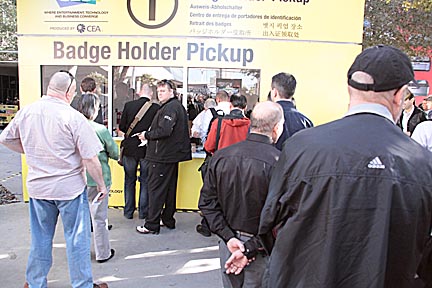
There
were at least two check-in centers like this one at the convention
center. In addition to the three windows seen here,
there
were five more on the side. Check-in averages one minute per person
and the lines can be long on the opening day. I
recommend
bringing something to read.
As you wait in line, there and dozens of convention organizers who check the tickets of people in line to make sure they have everything required, tell them where to go if there's a problem and make sure they are in the right line... except in my case. It turns out there is a separate check-in location for press. After waiting in line for 20 minutes I ended being told to go to another location. The line there looked half a mile long but it turned out more convention associates were walking up and down the line checking in people where they stood. It turned out there was a single line for both check-in and getting into the press room for presentations.
Once check-in is complete you are free to enter any of the convention halls, several of which are so large that they would more properly be called stadiums.
So what's being inside the CES like? Imagine a slow cattle stampede with the cattle going all different directions. It's so crowded that getting around requires you to learn how to work your way sideways through the mass of humanity rather like a snake contorting itself as it slides through a thicket. Many times I got swept along by the crush of people and ended up going places I didn't want to be. Many more times it took ten minutes or more to work my way close enough to a display to see what was there. Many exhibitors make matters worse by poor layouts. LG was guilty of the worse offense by placing their OLED television display at the narrow juncture of five main walkways. The crowd looking that these TVs froze traffic to a stand still. In spite of cool winter temperatures and enough air conditioning to halt global warming, the mass of people in the convention center was so great it was uncomfortably hot and humid. Like most attendees I wore a sport coat to reflect the professional nature of the event. And just like most people I quickly removed it and ended up carrying it the entire time.
At this point I have to warn anyone not familiar with Las Vegas and who intend to walk to the convention center from any of the close-by hotels that Vegas is one of the dirtiest towns in the nation, and I don't necessarily mean morally.
While the hotels and casinos are wonderlands of pristine cleanliness, most of the town is a dump. The walk from my hotel, the Sahara, to the CES was only half a mile. Yet in that short distance I had travel filthy, stained sidewalks that were cracked and when patched, poorly done. Weeds had taken over all landscaping not immediately in front of a major hotel, trash littered the landscaping, roads were cracked, the city scape was broken by new construction everywhere, many buildings looked old and tired, I was asked for handouts twice and there are long banks of newspaper-like vending machine every half block dispensing pornography and advertising prostitution (listed as entertainment.) My problem with this is that the CES is a major international event. Everyone visiting the US from a foreign country is going to think that this is what all of the United States is like. I was profoundly embarrassed.
My
first task at the 2010 CES was to visit blu-ray player manufacturers
to ask them if their blu-ray players have a zoom feature and if not,
why not. This is where I got my biggest surprise at the convention,
and my biggest disappointment.
Ten months earlier I conducted a survey of 13 different brands and makes of blu-ray players to see which can zoom a blu-ray movie. Only one, LG, does. All the others default this ability to the TV. There's two problems with this. First, every TV I've researched has a very limited zooming ability, which isn't always available for all mediums. If your goal is to zoom a 2.4/1 aspect ratio movie so it fills a 1.8/1 standard wide screen TV, these fixed settings don't provide the control needed to do this. (Note: I don't want to get into the debate about whether one should or shouldn't zoom movies. There are merits for both doing it and not.) LG is the only company that has a zoom feature for blu-ray movies and it's divided into 16 increments so the viewer has complete control over how much zoom he or she desires.
I was interested to see if any other manufacturers were planning to add this feature to their blu-ray players. The short answer was: "No." What was more interesting, and disappointing, was none of the company representatives knew if their players could do it. They all had to go find a higher-level expert to find this fact out. And many of these second-tier experts didn't know either. Now these were people working the blu-ray display, yet they didn't know what their own products could and couldn't do. Even the LG representative didn't know that their players could zoom. It was if they were people who had been taken off the street and handed a card with a few sound bites to memorize about the product and then posted at their display. None of them could answer why their players didn't offer zoom capability.
A similar thing happened at the Canon camera main desk. I asked if they had any plans to upgrade their 300mm prime lens in response to Nikon doing so to their high end 300mm lens and the representative said, "I don't think so." These people are supposed to be impressing potential buyers to convince them to purchase their products. To do so you'd think the companies would make sure they new their products and upcoming developments. As bad as that was it quickly got worse. The Canon 300mm L lens is one of the greatest lenses ever made, with a $6500.00 price tag to prove it. I had never seen one in person so I asked the representative to point it out to me in their display case. First he pointed to a 300mm non-L lens (the L specifies Canon's top-of-the-line lenses), then a vastly inferior 300mm DO lens. He simply didn't know what his own company's best lens looked like. Amazing.
Next on my to-do list was to check out the state of the art of televisions. From the number and size of the displays, it seems clear that LCD TVs are beginning to dominate plasmas. A big driver for this is that consumers want thin, light weight sets. LCD technology linked with LED back lighting can do this much better than plasmas. I saw many sets by several different manufacturers with thicknesses much less than one inch.

Many of these ultra-thin sets run so cool that they can be mounted flush to a wall without providing an air gap for circulation.
The drive for thinness was also evident in all the sets I saw having much narrower bezels (frames) around the image area of the TV.
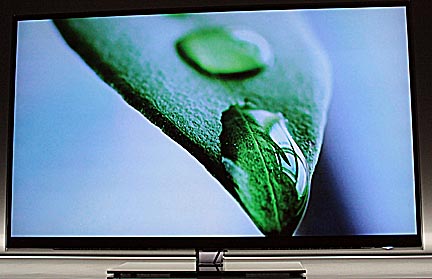
One year ago the average bezel was three inches wide. At the CES this average was reduced to one inch.
One of the most impressive displays was the 152-inch plasma by Panasonic.
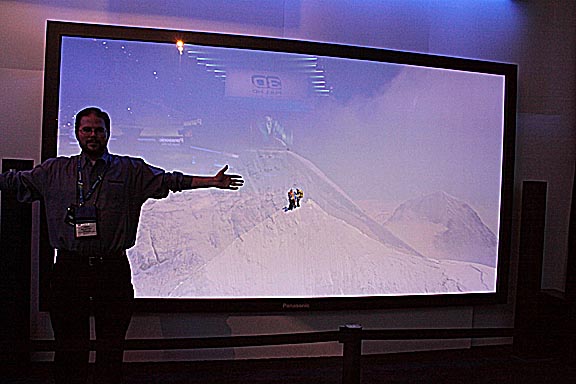
It appeared much larger in person than the photo above suggests. Image quality was outstanding with absolutely no pixelization even standing as close as five feet, thanks to its 4000x6000 pixel count. However, it featured a special ultra-high definition video specially made for the display. A regular DVD or even blu-ray movie would look jagged even after line quadrupling unless you were 20 feet away from it.
One of the highlights of the show was LG's proud display of a dozen 15-inch OLED televisions. They looked great are were almost as thin as a credit card.

The representative refused to state a price but suggested that when released later this year, they would be less than last year's offering. This would be Sony's 7-inch model retailing for $2,500. It's clear that LG is marketing it as a novelty item for the rich and famous. Considering that it's taken three years to increase the size of OLED sets from 7 to 15 inches, because of the vastly less expensive and well intrenched LCD and Plasma sets and the nearly as thin LED backlit LCD TVs it's doubtful that OLEDs will ever become a dominant technology. But that doesn't mean they aren't being pushed.
Although Sony, who introduced OLEDs two years ago, did not have a dedicated OLED display, they used many 20-inch class OLED sets to feature their 3-D technology.
One very interesting development was Sharp's quad-color technology. In addition to the three colors all other sets use to produce the 16 millions colors required to satisfy most viewer's demands for accurate color rendering, Sharp has developed a TV set with a fourth yellow pixel to broaden the range of the color gamut. The principle is the same used by many high end printers that use 6, 7 and even 8 different colors to produces more realistic pictures. The question is: "Where does the yellow come from?" The answer is that when a digital camera sees yellow, it converts it in a mixture of blue and green. In a sense, it compresses the yellow information into the blue and green channels. When this image is sent to a TV, the TV mixes blue and green (uncompresses it) to make the yellow. The weakness with this system is that the yellow channel has to be manipulated twice. Sharp's new sets eliminate the TV manipulation thereby improving the set's color accuracy. At least that's the theory. Their displays of this technology featured brilliant videos of fields of waving yellow sunflowers with the set's saturation turned up to maximum to emphasize the colors. Non-quad sets next to these appeared de-tuned creating an unfair comparison. Still, it's an interesting technology. Perhaps in the future there could be 4 or 5-color cameras and TV sets. The question is whether the improvement would be significant enough to justify retooling the entire industry.
Thin was also being pushed in laptop computers, with Intel's Ultra Adamo being one of the thinnest at 1/2-inch... folded.
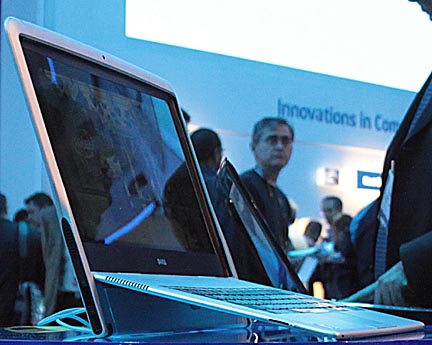
The biggest story was the push for home 3-D viewing capability. Every major brand had displays showing off their capabilities in this arena. All used glasses that looked like very weak sunglasses to merge what appears to the unaided eye to be three or four closely spaced multiple images. With the glasses these images merge into a single 3-D image with full depth of effect... sort of. I have to admit that while the technology was interesting, the final effect was not satisfying. The 3-D image looks a lot like the old viewmaster images, where there are two overlapping plains of objects that create a three dimensional effect. In the new TVs there appears to be four layers. The biggest problem is that when viewed with the glasses each layer is clearly defined and flat so that people a objects looks like paper cutouts. figures didn't look rounded like they are in real life. Watching for more than a few minutes gave me a headache. Another problem was that each layer was in sharp focus, I suppose in an effort to emphasize the 3-D effect. In real life we focus on one object and others closer or further away are out of focus. The 3-D sets didn't do this and in so doing created an artificial, posterized look.
The CES covers acres of floor space featuring thousands of products. This brief page is only intended to provide a taste of what it's like and some of the pitfalls of attending. The CES is a great experience and I encourage anyone allowed to attend to do so at least once in their lives.
Return
to the mainpage and browse 100 other
subjects: everything from metal detectors to camera equipment.